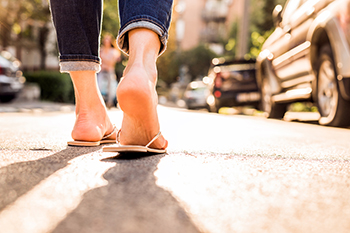Dangers of Wearing Flip Flops

As convenient and cooling as flip flops are, they can also put the health of your feet in danger. Because flip flops provide little arch support and minimal protection, wearing them can increase the chances of a sprained ankle, plantar fasciitis, and heel spurs. The thin soles on many pairs of flip flops also allow a greater likelihood of nails, glass, and other sharp objects poking through and into the foot. In some cases, a piece of the flip flop itself becomes embedded in the wound, and removing it may call for surgery. Because of their structure, flip flops necessarily result in the curling of the toes just to keep the shoes on. This may end up causing a permanent deformity of the toes, called a hammertoe. In this deformity, the middle joint of the toe sticks up. Then when regular shoes are worn, the hammertoe may begin to rub against the upper part of a shoe and cause pain. Because flip flops offer little to no arch support, the wearer steps flat, putting increased pressure on the ball of the foot. This can eventually cause inflammation and pain. If you have foot pain from regular or continued wearing of flip flops, it is suggested that you make an appointment with a chiropodist who can determine the best course of treatment.
Flip-flops, though they may seem harmless, are bad for your foot health. If you would like to learn more about the many problems that can be caused by frequent flip-flop wear, please consult with one of the specialists from Thornhill Foot Clinic. Our chiropodists can help you maintain the health of your lower limbs and your mobility.
Flip-flops are the quintessential summer shoe, seemingly perfect for the beach or pool. Unfortunately, these flimsy shoes are not a good choice when it comes to keeping your feet healthy.
Frequently wearing flip-flops is associated with:
Hammertoes
Bunions
Plantar fasciitis
Heel spurs
Cracked heels
Plantar warts
Athlete’s foot
Foot pain
Foot and ankle injuries
Gait changes
Leg, hip, and back pain
The best way to avoid these issues is to swap your flip-flops for more protective and supportive shoes. If you must wear flip-flops, wear them only for short periods of time.
If you have any questions, please feel free to contact our office located in . We offer the newest diagnostic and treatment technologies for all your foot care needs.
